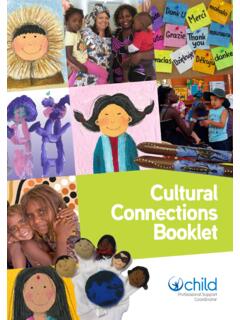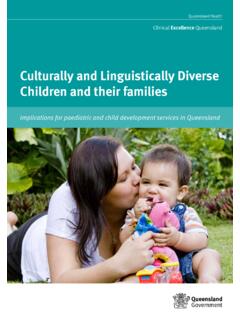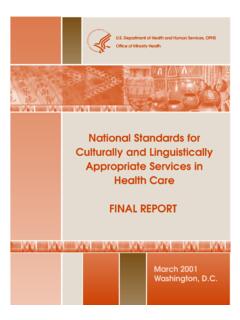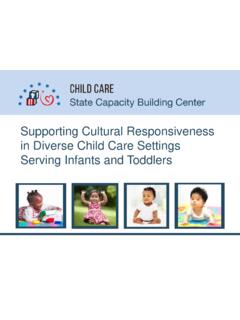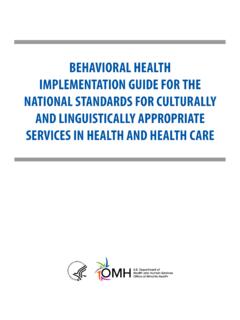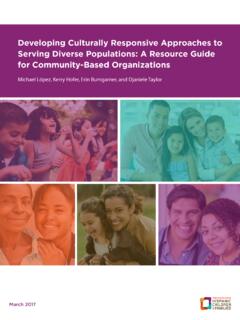Transcription of Welcoming conversations with culturally and linguistically ...
1 An Educators GuideWelcoming conversations with culturally and linguistically diverse familiesInclusion & Professional Support ProgramAustraliaChild Australia is the Professional Support Coordinator in Western Australia and Northern Territory under the Inclusion and Professional Support Program (IPSP).Acknowledgements We acknowledge the assistance and contribution of the staff, children and families from:Salvation Army Balga Child Care CentreMaranatha Early Learning Child Care CentreUWA Early Learning CentreChild Early Learning Centre LockridgeFarrar Early Learning CentreSudbury Community House Child Care CentreHoward Springs Early Learning Centre Child Australia, 2012 Principal Author: Jackie Goodsman, Child rights reserved by Child Australia.
2 Material herein may not be reproduced in any other form without resource is based on the most current information available in July 2012. In developing this resource we have referred to legislation and regulations, sought advice from professional organisations and reviewed contemporary research. This document should be used as a guide to compliment and develop service s existing policies and procedures. Services should always check the currency of information at the time of use and consider the information in this booklet in the context of their particular 4 Voices of CaLD Families 5 Walking in CaLD Family Footsteps Considering another perspective 6 First Impressions Count Everyone is welcome at our service 7 Enrolment Beginning to form connections 8 Service staff Sharing something of ourselves 10 Indoor play Value, choices and learning 11 Outdoor play Active.
3 Engaging and connecting with nature 13 Clean and Healthy Sharing the how and why 15 Healthy food and meal times Social occasions with a respect for culture 16 Sleep and rest Safe sleeping and respect for sleep rituals 18 Final thought 19 References 19 Welcoming conversations with culturally and linguistically diverse familiesWelcoming conversations with culturally and linguistically diverse families4 Welcoming conversations with culturally and linguistically diverse familiesIntroductionWhen new families come to your service, it is important for them to develop a sense of Belonging.
4 You develop this from your first interaction with them as you share information about your setting. It can sometimes be a little challenging to share important information with families who have English as a second language. As well as the obvious language barrier, there may also be differences between your world view and those of the family. These different viewpoints can sometimes cause confusion or misunderstanding about child care and parent participation. This Guide has been developed to help you to share information with families using a Visual Orientation Booklet that creates a story of your service and the unique care that you provide.
5 It is accompanied by: Sample Visual Orientation Booklet Template for your Visual Orientation Booklet The Educators Guide will assist you to have Welcoming conversations with culturally and linguistically Diverse Families (CaLD) using your Visual Orientation Booklet. Each section of the Educators Guide is linked to a specific part of the Visual Orientation Booklet. Reflective questions are provided to prompt your thinking as you orientate new families into your service. There are also suggestions for things you could try in your setting to make it a place that supports Welcoming conversations with CaLD Families.
6 You may also find the reflective questions useful in team meetings to generate you need the support of an interpreter to help you to share the Visual Orientation Booklet and important information about your service, contact the Professional Support Coordinator (PSC) in your State or Territory for more information or check their Visual Orientation Booklet The sample Visual Orientation Booklet shows how informative and engaging the booklet can be. Each page tells a little more of the story of your service. When you show the Visual Orientation Booklet to CaLD families, you begin to create connections with the family and develop an understanding of their needs.
7 Template for Visual Orientation Booklet The template allows you to drop in a range of photographs to create a unique and informative booklet for CaLD families and children. You may choose to create a booklet that focuses either on a particular room or the whole environment. Blank pages have been included to allow you to create other pages to share with families and children. Welcoming conversations with culturally and linguistically diverse families5 What helps you to feel welcome and what gives you a sense of belonging? Voices of CaLD FamiliesTo develop this Guide, we talked with CaLD families to learn about their thoughts, feelings and needs when arriving in Australia and entering a child care service for the first time.
8 We were curious to know what would help these families and their children to feel a sense of Belonging in Australia and in the child care community they have responses were varied but the key message was their need to be informed and included through respectful engagement and Welcoming environments. We hope that by sharing some of their comments you will feel more confident in developing your orientation booklet and having Welcoming conversations . Use the Visual Orientation Booklet and the suggestions in this Guide to help you inform and include CaLD families. The Booklet will also help you to: make your enrolment process more inclusive build a strong partnership with families develop or update your Quality Improvement Plan (QIP) as it links to NQS Quality Area 6 (Collaborative partnerships with families and communities) implement key principles and practices of the EYLF and FSAC - respect for diversity and cultural diversity means within the curriculum valuing and reflecting the practices, values and beliefs of families.
9 Educators honour the histories, cultures, languages, traditions, child rearing practices and lifestyle choices of families. (Early Years Learning Framework p. 13) When you acknowledge my presence Being treated as an equal Not being judged Being listened to and given information Being able to trust and being trusted Seeing educators communicate with my child using some of my child s first language Feeling and seeing respect for other cultures Feeling safe and free Being able to enjoy my culture, the music, food, celebrations and language Access to education for ourselves and our children Being asked by educators about my child s routine, how they sleep.
10 What food and drink they can have Being asked about my child rearing practices Hearing educators ask my child about play, songs and stories they likeWelcoming conversations with culturally and linguistically diverse families6 Walking in CaLD Family Footsteps - Considering another perspective When new CaLD families arrive at your door for the first time, they won t know your service structure, philosophy or processes. Your Parent Handbook and other documents will probably be in English and could be overwhelming for some families who have English as a second yourself in a non-English speaking country where nothing is familiar.



